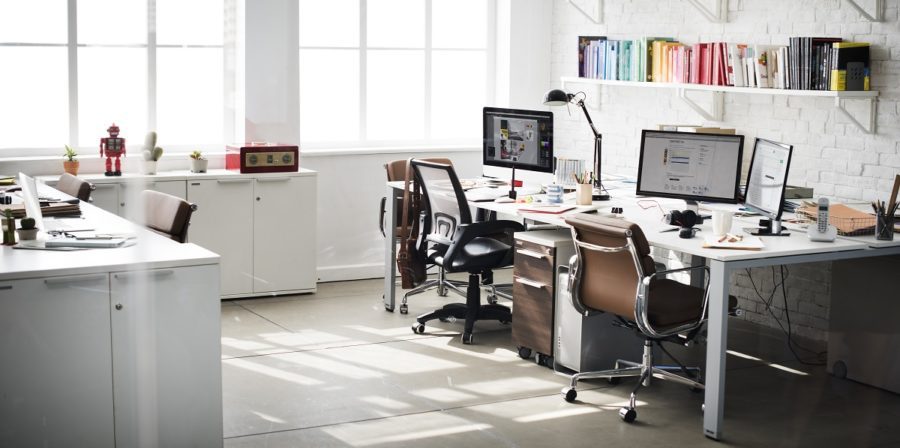
Commercial
5 Office Organization Ideas
4 Min Read
Written by: Parcel Pending
The quality of office life has seen a significant boost as people return to communal workspaces and level-up with new tools. Whether you’re looking for a promotion that acknowledges your excellent office management skills or you’re just an enthusiastic employee, office organization is one way to make the work space a more productive and comfortable environment that is better adapted to employee needs.
1. Audit & Declutter
The best offices incorporate both elegant and thoughtful touches to create a design for a productive work environment. But even the best designed office will not be a pleasant place to work if the physical space is not well kept and well organized.
Office supplies and tech equipment that is not used regularly should be stored away from the main office area to avoid creating clutter. Supplies that are necessary to get the job done should be quick to access and in obvious places. Ultimately, the focus of a flexible office space should be business functionality.
Most offices (even a small office) could use an audit, where office supplies are cataloged and accounted for to help reduce clutter around the office. An audit helps employees waste less time searching for materials they need when supplies run low. It also helps better organize the work space by making room for bigger or smaller items and hot desking equipment that can improve workflows and empower people to do their best.
2. Automate Recurring Tasks
Automating or hiring third-party suppliers to restock and keep track of office supplies and food can help save employees time and energy. This also lets employees focus their attention on the job they were hired to do (rather than office organization) and helps generate a positive, productive work environment.
If some office management tasks are becoming too time-consuming, consider looking for outside help. Some of the tedious tasks required to organize and keep an office clutter-free or well-stocked can be automated by a local service or a new app. A good office organization strategy is to regularly search out for new automation opportunities that can free up your employees for higher-order thinking, creativity, and decision making.
3. Track Inbound Requests
Keeping track of orders, deliverables, and other important documents with Excel spreadsheets or with software like ZenDesk can make day-to-day operations smoother and more predictable. And newer tools like Asana or Trello allow managers see a high-level overview of all employee activities so they can offer assistance where needed – without micromanaging. These new technologies also help empower employees to communicate quickly and easily with one another on a user-friendly channel.
4. Get Back to Basics
In the age of hybrid work and hot desking, office organization is an old-school idea that is merging with new tools to make life better for employees on-site, on the road, or at their home office. Organization and improving the work-life balance is key to successful return-to-work strategies.
A healthy and pleasant work environment can go a long way to encouraging employees to spend more time at their desk at the office, improve team building, and encourage employee productivity. Office features such as good ventilation and healthy snacks, as well as something as simple as good computer cable management, can help encourage a tidy and well-kept work space and desk space. As the saying goes, a healthy office space encourages a healthy mind!
5. Smart Lockers
Looking for office storage ideas other than hanging shelves, a desk organizer, or office supply cabinets? Smart commercial lockers allow safety-conscious employees to receive packages or exchange assets quickly, easily, and without requiring contact with other employees and can even reduce paper clutter or supply clutter in the work space. For instance, when an important document is ready for another team member to pick up, you can put it in a parcel locker, and when they arrive, they can get the code to retrieve the document – all without face-to-face interaction.
Smart lockers also give employees piece of mind so that when they arrive at their desk (even if they are sharing desk space) they can know their work package deliveries, important documents, or even that flash drive they requested from IT for a site visit are all secure and ready to pick up at their convenience.
Employees also appreciate the fact that smart lockers can be easily accessed with a code they receive on their smartphones. Even if they are working from their home office, they can drop by their local office work space, and use the smart electronic locker system to easily grab what they need and go directly to any meeting or event.
Integrated smart locker solutions, such as Parcel Pending by Quadient’s Campus Hub™, can help employers maximize business activity with secure delivery for packages, IT assets, and other asset exchanges required in their workplace. By leveraging asset tracking systems (like Quadient’s WTS) employers can also ensure a full chain-of-custody for each item placed in the locker system.
With the concerns about contactless delivery and secure asset exchanges, smart locker technology can play an important role in improving business processes. Smart lockers facilitate transactions, the delivery of goods and important documents, and can support all kinds of other asset exchanges – including IT equipment, onboarding materials, in-house printing jobs, uniforms, and tools. Increased delivery efficiency can lead to higher employee productivity, plus businesses are continuing to discover new logistics potential with this innovative technology.
To find out more about how our locker solutions can increase productivity and efficiency for your business, contact a Parcel Pending representative today.





